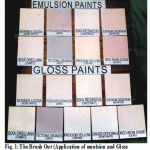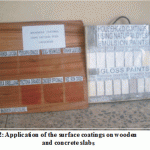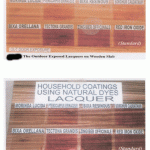How to Cite | Publication History | PlumX Article Matrix
Development of Household Surface Coatings Using Some High Tinctorial Natural Dyes
Abayomi Olagundoye Adetuyi1 and Mojibola Abdul-Akeem Alaba1
Department of Industrial Chemistry, Federal University of Technology, Akure, Ondo State Nigeria.
Corresponding Author E-mail: yomiadetuyi2002@yahoo.com
ABSTRACT: Pigments from six Nigerian floras namely Morinda lucida, Bixa orellana, Sorghum caudataum, Pterocarpus erinaceous, Tectona grandis and Zingiber officinale were successfully isolated and compounded through formulation into household surface coatings as emulsion paints, gloss paints and lacquers using a paint industry’s procedure. The formulated surface coatings with the natural dyes compared favorably well with the standards in terms of having high opacity on Morest chart, viscosity and high fastness properties of above 4.0 on a Gray scale of 5.0 as interior coatings. The lacquers proved highly effective and acceptable as wood finishes.
KEYWORDS: Coatings; emulsion; gloss; lacquer; natural dyes; paints
Download this article as:| Copy the following to cite this article: Adetuyi A. O ,Alaba M. A. A .Development of Household Surface Coatings Using Some High Tinctorial Natural Dyes.Biosci Biotechnol Res Asia 2010;7(1) |
| Copy the following to cite this URL: Adetuyi A. O ,Alaba M. A. A .Development of Household Surface Coatings Using Some High Tinctorial Natural Dyes.Biosci Biotechnol Res Asia 2010;7(1). Available from: https://www.biotech-asia.org/?p=8929 |
Introduction
Surface coating is a material in liquid or powder form that when applied to a substrate forms a film possessing protective, decorative and or other specific properties1. The extent to which the use of coatings, colourants and paints can be utilized is an index of progress toward modern cilivilization. Organic coatings are based on a vehicle, usually an oil or resin, which after being spread out in a relatively thin film changes to solid. This change called drying may be entirely due to evaporation of a volatile solvent or by a chemical reaction, such as oxidation or polymerization1.
Surface coatings could be paints, vanishes and lacquers. Paint is a liquid composition of a pigment suspended in a vehicle which after application in its liquid form to a substrate, changes or hardens and dries to form a solid opaque film 2. Paints applied to materials changes the surface properties of the material such as gloss, colour, resistance to wear and chemical attack or permeability, without changing the bulk properties 3. Vanishes are clear, unpigmented coatings, made by dissolving a resin (or the reaction product of a resin and a drying oil), in a suitable solvent. Lacquers are coatings for which the vehicle is a cellulose derivative. It dries by the evaporation of the solvent or thinner and forms a protective film from its non volatile contents. Lacquers are characterized by its rapid drying and distinctive odour 4. Surface coating quality is judged by the length of time during which the material maintains its decorative and protective value. Different types of coating provide different application and resistance of properties, depending on the kinds and levels of ingredients used to formulate the coating. Some of the application and appearance properties of coatings include: colour, opacity, flow and leveling, sheen gloss level, spattering and foaming tendencies and also adhesion among others. In general terms, all coatings have five basic components which impact these properties mentioned above. These components are: pigments, binder (film-former), solvents/ thinner, extenders and additives. The roles of this individual component in surface coatings, as well as the production and application techniques of surface coatings are found in literatures 5-7. Coatings could be classified in various ways according to: end use (decorative, auto, industrial and marine); solvent used (water based / solvent based) and higher performance or special type coatings. This study had been prompted by the reported high tinctorial strength for the natural dyes used in the formulation, namely: Bixa orellana, Morinda lucida, Pterocarpus erinaceous, Sorghum caudatum, Tectona grandis and Zingiber officinale 8, 9. It has as its main objective, the use of these natural dyes as main pigments in the formulation of surface coatings, particularly, emulsion and gloss paints, and lacquers, for household utilization. The performance properties of the resulted formulated surface coatings are then studied and compared with the surface coatings prepared with synthetic dye (Procion yellow), organic and inorganic pigments (red iron oxides) as standards.
Materials and Methods
Sources of materials and preparations
Natural dyes from the following plants: Bixa orellana and its resins, Morinda Lucida, Pterocarpus erinaceous, Sorghum caudatum, Tectona grandis and Zingiber officinale were collected from the Industrial Chemistry Department, Federal University of Technology, Akure, Nigeria. Procion yellow R dye and other surface coating formulation materials were obtained from Nigerian Textile mills PLC and Niger Cedar Industries Limited, Ikeja, Nigeria respectively. The above named natural pigments in conjunction with other surface coating materials as obtained from the Industry were formulated into gloss, emulsion and Lacquers according to the procedure of Niger Cedal Indusries limited, Nigeria. Prior to the formulations, the natural dyes were pre-dissolved in a little alkaline solution (5 ml). Various assessment tests as oil absorption, viscosity, opacity, drying time among others, were carried out on the products using Nigeria Industrial standard 10(NIS) methods.
Results and Discussion
The results obtained from the assessment tests were shown in Tables I- V. Table I show the colour of the finished surface coatings products. The textures of most of the natural dyes which were not smooth were improved through grinding to increase their surface area as well as their oil absorption properties. The oil absorption properties of the natural dyes compared to the standard were high and this reduces their rate of dispersion in the vehicle (water/kerosene) and hence, required excessive mixing (Table II). Other physical parameters tested compared favorably well with the standard (Table III). Viscosity is defined as the resistance to flow of a liquid paint. All the coatings, include the standards has good viscosity and these facilitates their ease of application and spreading rate. The coatings so formulated showed a considerable good obliterating power (opacity) on Morest chart and this was manifested on the applied substrates- concrete and wooden slabs (Fig.1 and Fig.2). The emulsion paints prepared with Morinda and the Bixas showed high resistance to water while others including the standards vary slightly in hues. However, all their corresponding gloss (except Procion yellow) and lacquers exhibited high resistance to water (Table IV). There were no considerable changes in the overall properties of the coatings. They showed good adhesions, indicating that the surface coatings were adequately formulated and the binder used (Polyvinyl acetate) has good binding strength 11.
Table 1: The final colour imparted by the dye/pigment samples in the finished surface coating Products.
| Dye/pigment samples | Emulsion paints* | Gloss paints* | Lacquers |
| Morinda Lucida | Bone white | Bone white | Gold |
| Pterocarpus erinaceous | Serria | Serria | Grey |
| Bixa resionous | Chestnut | Chestnut | Golden orange |
| Sorghum caudataum | Mushroom | Mushroom | Dark red |
| Tectona grandis | Grey | Grey | Wine |
| Zingiber officinale | – | Bone white | Golden brown |
| Procion yellow (synthetic) (STD) | Cream | Cream | – |
| Organic red iron oxide (STD) | – | – | Brown |
| Inorganic red iron oxide (STD) | Lilac | Lilac |
*The colour in accordance with Niger Cedar Industries Colour Chart.
STD = Standard pigment/dye
Table 2: The physico-chemical parameter of the pigments/dye
| DYE/PIGMENT SAMPLES | COLOUR | TEXTURE | Weight of oil absorbed (gram) | pH values (emulsion paint) |
| Morinda lucida | Golden brown | Crumble | 19.40 | 8.61 |
| Pterocarpus erinaceous | Black | Coarse | 14.90 | 8.70 |
| Bixa resinous | Golden red | Crumble | 13.40 | 8.80 |
| Sorghum caudataum | Black | Coarse | 10.00 | 8.73 |
| Bixa orellana | Red | Coarse | 6.00 | 8.98 |
| Tectona grandis | Black | Coarse | 10.20 | 8.90 |
| Zingiber officinale | Bright red | Coarse | 9.00 | – |
| Procion yellow (synthetic) (STD) | Deep red | Smooth | 4.00 | 7.80 |
| Organic red iron oxide(STD) | Red | Smooth | 3.40 | – |
| Inorganic red iron oxide(STD) | Red | Smooth | 3.60 | 7.50 |
Table 3: The Viscosity values of finished surface coating products.
| Dye/pigment samples | Viscosity | ||
| Emulsion (Pascal sec) | Gloss (secs) | Lacquer (secs) | |
| Morinda lucida | 11.00 | 110.0 | 26.0 |
| Pterocarpus erinaceous | 11.00 | 111.0 | 27.0 |
| Bixa resinous | 11.10 | 110.0 | 25.0 |
| Sorghum caudataum | 10.90 | 114.0 | 26.0 |
| Bixa orellana | 11.00 | 113.0 | 25.0 |
| Tectona grandis | 11.00 | 112.0 | 27.0 |
| Zingiber officinale | – | 116.0 | 28.0 |
| Procion yellow (synthetic) (STD) | 10.80 | 110.0 | 26.0 |
| Organic red iron oxide(STD) | – | – | 26.0 |
| Inorganic red iron oxide(STD) | 11.00 | 110.0 | |
Table 4: The water resistance test results on the finished surface coating Products.
| DYE/PIGMENT SAMPLES | Water resistance | ||
| Emulsion paints | Gloss paints | Lacquers | |
| Morinda lucida | + | + | + |
| Pterocarpus erinaceous | – | + | + |
| Bixa resinous | + | + | + |
| Sorghum caudataum | – | + | + |
| Bixa orellana | + | + | + |
| Tectona grandis | – | + | + |
| Zingiber officinale | – | + | + |
| Procion yellow (synthetic) (STD) | – | – | + |
| Organic red iron oxide(STD) | – | + | + |
| Inorganic red iron oxide(STD) | – | + | + |
Key: + = High resistance, no colour change= Low resistance, slight colour change
Table 5: The Mean Light Fastness Results of the Finished Paint Products after 5 weeks of exposure
| Dye/pigment samples | Emulsion | Gloss | Lacquer | |||
| Indoor | Outdoor | Indoor | Outdoor | Indoor | Outdoor | |
| Morinda lucida | 4.40 | 3.60 | 4.60 | 3.80 | 4.80 | 4.40 |
| Pterocarpus erinaceous | 4.40 | 2.80 | 3.60 | 2.80 | 4.40 | 4.00 |
| Bixa resinous | 4.40 | 3.80 | 4.20 | 3.80 | 4.40 | 3.80 |
| Sorghum caudataum | 3.20 | 2.40 | 3.80 | 3.00 | 4.40 | 3.80 |
| Bixa orellana | 4.20 | 3.60 | 4.40 | 3.80 | 4.40 | 3.80 |
| Tectona grandis | 3.80 | 2.60 | 4.40 | 3.20 | 4.80 | 4.20 |
| Zingiber officinale | – | – | 3.60 | 2.80 | 4.20 | 3.80 |
| Procion yellow (synthetic) (STD) | 4.40 | 2.40 | 3.80 | 2.80 | – | – |
| Organic red iron oxide (STD) | – | – | – | – | 5.0 | 5.0 |
| Inorganic red iron oxide (STD) | 5.0 | 5.0 | 5.0 | 5.0 | ||
Key: Grey scale rating:1 – 2 Poor Light Fastness 3 – 4 Good Light Fastness >5 Very good Light Fastness
The formulated surface coatings from natural dyes showed relatively brighter colours, particularly those made using the pigments of Morinda, Tectona, Pterocarpus and Zingiber (fig. 1). In lacquers, Zingiber and Bixa manifested a golden brown and transparent orange colour respectively when cured. These are desirable hue, attractive and effective as wood finishes on household furniture when applied (Fig.3). Generally, all the surface coatings include the standard, exhibited low fading resistance to light in outdoor exposures (Table V). This is due to the fugitive nature of the pigments. Their hues changes after exposure to light energy for five weeks.
 |
Figure 1
|
 |
Figure 2
|
 |
Figure 3
|
Conclusion
The natural dyes used in this study showed good tinting strength (hiding power), water resistance and high compatibility with other ingredients of surface coatings’ formulation. Nevertheless, they are not strong towards high radiation energy and these would restrict their uses as exterior surface coatings. However, for ingenuity and originality, they would serve well as paints on concrete walls or lacquers on wood finishes for interior decorative purposes.
Acknowledgment
The authors are grateful to the Nigerian Textile mills PLC, for supplying the Procion yellow dye and Niger Cedar Industries Limited, Ikeja, Lagos, Nigeria, for providing the other surface coating materials and for the use of some of their machines respectively.
References
- Achi, S. S, Basic principle of coating technology, Shemang Graphics, Zaria, Nigeria.Pp (2003), pp 1-56.
- Turner, G. P.A., Paint chemistry and principles of paint technology, Chapman & Hall, England. (1989), pp14-18.
- Guy, E.W, Paint handbook, McGraw Hill Press, USA. (1981), 35-38
- William, B., Painting and decorating encyclopedia, Goldenheat Willcox Co. Inc., USA. (1982) p. 16
- Tellford, J.W and Chai, S.K, Introduction to basic paint technology, Van Nostrand-Reinhold, England. (1999), pp1-6
- Landbourn, R, Paint and surface coatings: theory and practice, Ellis horword Ltd., Chichester, UK. (1987), p89-90
- Morgan, W.M, Outlines of paint technology, 3rd Edition, EdwardArnold Publish, London. (1988), 2-5, 60-79.
- Adetuyi, A.O, Extracting spectroscopic studies and uses of some natural dyes. Unpublished Ph. D thesis, Department of chemistry, Federal University of Technology, Akure, Ondo State. (2004), p146-148.
- Adetuyi, A.O., Popoola A.V. and Lajide, L, “The additive values of biodegradable natural pigments, ”peer-reviewed proceedings of 16th Annual Conference of Biotechnology Society of Nigeria (BSN), (2003), pp 195-198.
- Nigeria Industrial Standard (NIS), Standard test methods for paints and varnishes, Vol. 28, Part1-6, Standard organization of Nigeria (SON), Lagos, Nigeria. (1990)
- Seymour, R.B. and Mark, H.F, Organic coatings: their origin and development, Elsevier, Amstardam, Netherlands. (1990), p 16, 92,102

This work is licensed under a Creative Commons Attribution 4.0 International License.





